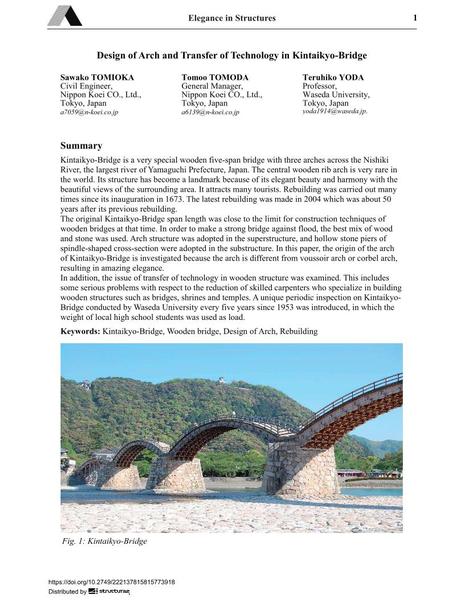Design of Arch and Transfer of Technology in Kintaikyo-Bridge

|
|
|||||||||||
Détails bibliographiques
| Auteur(s): |
Sawako Tomioka
Tomoo Tomoda Teruhiko Yoda |
||||
|---|---|---|---|---|---|
| Médium: | papier de conférence | ||||
| Langue(s): | anglais | ||||
| Conférence: | IABSE Conference: Elegance in structures, Nara, Japan, 13-15 May 2015 | ||||
| Publié dans: | IABSE Conference Nara 2015 | ||||
|
|||||
| Page(s): | 56-57 | ||||
| Nombre total de pages (du PDF): | 8 | ||||
| Année: | 2015 | ||||
| DOI: | 10.2749/222137815815773918 | ||||
| Abstrait: |
Kintaikyo-Bridge is a very special wooden five-span bridge with three arches across the Nishiki River, the largest river of Yamaguchi Prefecture, Japan. The central wooden rib arch is very rare in the world. Its structure has become a landmark because of its elegant beauty and harmony with the beautiful views of the surrounding area. It attracts many tourists. Rebuilding was carried out many times since its inauguration in 1673. The latest rebuilding was made in 2004 which was about 50 years after its previous rebuilding. The original Kintaikyo-Bridge span length was close to the limit for construction techniques of wooden bridges at that time. In order to make a strong bridge against flood, the best mix of wood and stone was used. Arch structure was adopted in the superstructure, and hollow stone piers of spindle-shaped cross-section were adopted in the substructure. In this paper, the origin of the arch of Kintaikyo-Bridge is investigated because the arch is different from voussoir arch or corbel arch, resulting in amazing elegance. In addition, the issue of transfer of technology in wooden structure was examined. This includes some serious problems with respect to the reduction of skilled carpenters who specialize in building wooden structures such as bridges, shrines and temples. A unique periodic inspection on Kintaikyo- Bridge conducted by Waseda University every five years since 1953 was introduced, in which the weight of local high school students was used as load. |
||||
| Mots-clé: |
pont en bois
|
||||
